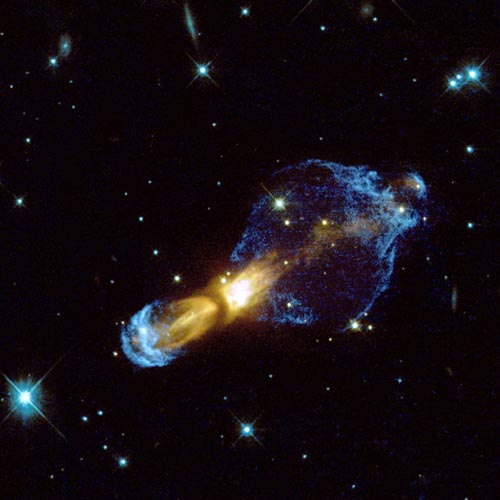
Planetary nebula
RA 07h 42m 16.83s Dec -14° 42' 52.1"
Puppis
4500 light-years
9.47
1.4 light-years wide
Hubble Space Telescope WFPC2
ESA & Valentin Bujarrabal (Observatorio Astronomico Nacional, Spain)
August 24, 2001
2017 image: N1705
ABOUT THIS IMAGE:
A new, detailed Hubble image of a planetary nebula in the making shows for the first time the complex gas structures predicted by theory. Astronomers are thrilled by observations showing the violent gas collisions that give rise to supersonic shock fronts.
Stars like our Sun will eventually expel most of their material out into a planetary nebula. This is in the process of happening to an object called OH231.8+4.2 - a proto-planetary nebula surrounding a cool and dying star. The system is better known as the Calabash Nebula because of its peculiar shape. Another nickname for this object - the Rotten Egg Nebula - is derived from the large amount of sulphur compounds present, which would certainly produce an unpleasant smell if one could smell in space.
The nebula is composed of gas ejected by the central star and subsequently accelerated in opposite directions. The gas (coloured yellow in the image) has reached tremendous velocities of up to one and a half million kilometres per hour. The ejection process is so efficient that most of the stellar mass is now contained in these bipolar gas structures.
A team of Spanish and American astronomers has used the NASA/ESA Hubble Space Telescope to study how the gas stream rams into the surrounding material (shown in blue). Such interactions are believed to dominate the formation process in planetary nebulae. Due to the high speed of the gas, shock-fronts are formed on impact and these heat the surrounding gas. Although computer calculations have predicted the existence and structure of such shocks for some time, the observational evidence has so far been poor.
This new Hubble image reveals the shocks in impressive detail. Using filters that only let through light from ionised hydrogen and nitrogen atoms, astronomers have been able to distinguish the warmest parts of the gas heated by the violent shocks and have found that they form a complex double-bubble shape. The bright yellow-orange colours in the picture show how the high- speed gas is flowing from the star - like two supersonic speeding bullets ripping through a medium in opposite directions. The central star itself is hidden in the dusty band at the centre. 'This is the first time that these shock components have been seen clearly in such a nebula,' says Valentin Bujarrabal from the Observatorio Astronomico Nacional in Spain. 'The deep, high- resolution images show the complex structure of the shocks in great detail, which we can now compare with predictions from computer models.'
'In the image we can see how the shocks have broken through the surrounding gas. We believe we can see both of the shock components we expect - the forward and the backward shockwaves,' states Valentin Bujarrabal.
Much of the gas flow observed today seems to stem from a sudden acceleration that took place only about 800 years ago. The astronomers believe that in yet another 1000 years from now the Calabash Nebula will evolve into a fully developed planetary nebula - like a butterfly emerging from its cocoon.
The Calabash Nebula is 1.4 light-years along its longest extent and located in an open stellar cluster some 5000 light-years away in the constellation Puppis.
The Hubble image was taken shortly before Christmas 2000 with the WFPC2 instrument (Wide Field and Planetary Camera 2) in four different filters. Here, light from 791 nm is displayed in red (exposure time 900 s), 675 nm in green (900 s), while combined light from hydrogen (656 nm) and ionised nitrogen atoms (658 nm) are shown as blue (14,700 s).
Filters: Optical: Blue: H-alpha + Nii 658 nm; Green: R 675 nm Infrared: Red: I 791 nm